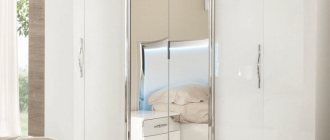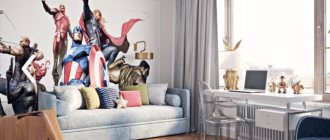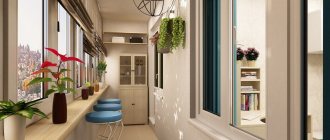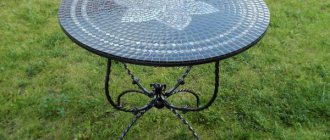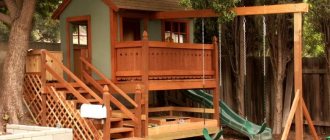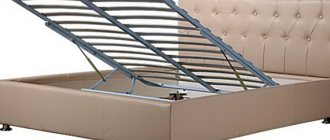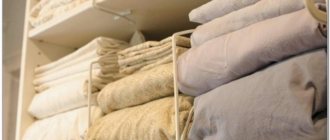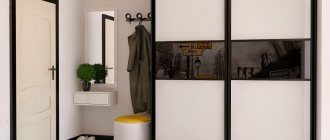19838
Owners of large personal wardrobes often do not understand how to organize the issue of storing it. If there is not enough space in the apartment to build a dressing room, you can choose an alternative. Next, you will see in the photo and tips from experienced specialists how beautiful, practical, and functional a well-chosen wardrobe can be.
Purpose
Modern furniture for residential premises is very diverse in its purpose, design, size, shape and internal content. And each family selects its own set of pieces of furniture based on its own preferences. But almost every apartment has a small or large wardrobe. It is also called wardrobe or dress. Such furniture replaced bulky chests, which were of little functionality, and is used to organize storage issues for a person’s personal wardrobe.
An original design wall with a wardrobe in the Provence style looks very attractive, allows you to place things and bring an atmosphere of comfort to your home. If you think carefully about the “filling” of your wardrobe, it will fit clothes, shoes, bags, belts, and jewelry. Many people even store sports equipment, ironing boards or bedding inside such structures.
The history and evolution of the wardrobe
Modern wardrobe modules have gone through a long evolution. The ancestor of the wardrobe is the chest. Until the end of the 15th century, a wooden chest with handles and a lid attached to forged hinges was the main piece of furniture. Not only were clothes stored in the chests, they were also used as a chair and as a sleeping place. At the end of the 15th century, humanity came up with the brilliant idea to install the chest in a vertical position.
From that very moment, the real history of the development of a popular piece of furniture began. The design was supplemented with shelves and drawers. The design of the closet began to change rapidly; the once rough chest made of boards was transformed into a pompous product made of expensive wood. The walls began to be decorated with carved elements, openwork metal overlays, inlays, and paintings.
In the 18th century, a gradation of furniture products appeared, and cabinets began to be classified according to their purpose. The concepts of a cabinet-office, a cabinet-cabinet for business papers, and a wardrobe appeared.
Kinds
Let's look at the most popular types of wardrobes today to understand which model is relevant for a particular case.
According to the opening system
If you carefully study the door opening system that a wardrobe can be equipped with, they are all divided into several types:
- wardrobe with mezzanine, hinged doors. Roomy models, the height of which can reach 2.4 m, width - 1.-2 m, and depth - 0.4-0.6 m;
- compartment - even a small living room in Provence style or a bedroom with a wardrobe will be very functional, since such furniture is very compact and fits even in narrow spaces. The doors of such a cabinet move sideways along guides, since the design contains special rollers, and its depth can be varied.
Closet
Swing
By number of doors
If we consider the structure of such furniture, we can distinguish single-leaf or double-leaf options. A single door wardrobe can hold a lot of things; the design has only one door, which swings outwards. In the second version, the closet has two doors, but they can be not only hinged, but also compartment doors.
You can also choose a model with three doors, where two of them are compartments, and the third is a hinged one. Often, such models have a hinged door that hides drawers and shelves, and behind the compartment doors there is a large space with a crossbar and hangers on it.
According to the material of manufacture
Nowadays, furniture is made from a wide variety of materials, but buyers are increasingly giving preference to the following types:
- made of solid wood (pine, alder, oak, etc.). As practice has shown for many years, a wardrobe made of solid natural wood is the most durable, practical and respectable option. It is distinguished by the maximum level of naturalness, resistance to wear, looks expensive, and has a natural smell of wood (pine gives a particularly pleasant smell). The only thing that can scare off buyers is the high cost of a wardrobe made of solid wood in the Provence style, because it is classified not as a “standard” class, but as an “elite” one;
- MDF - a wardrobe made of MDF has a varied design, since the material is made in a wide range of colors, patterns, and textures. MDF goes well with glass and chrome elements, so furniture made from this material often has original decor. The operational parameters of such structures are above average, and the service life is quite long;
- Chipboard - this material is affordable and has average resistance to negative environmental factors. Chipboard swells with prolonged exposure to water, can fade with prolonged contact with direct sunlight, it is difficult to remove children's markers from its surface, and does not absorb the smell of food. However, a children's wardrobe is the most profitable purchase for a baby. It is used to make standard models that are highly economical. As a child grows, his needs and wardrobe change, so within two to three years after purchasing a wardrobe, it may no longer be needed. Due to the low cost of chipboard models, they are the ones that parents prefer more often than others.
Wood
Chipboard
MDF
By accommodation option
The installation location of the wardrobe will determine the features of its contents, main parameters, and external aesthetics:
- corridor - for a narrow space, you need a compact wardrobe, with compartment doors, preferably in a light color, but not black. The optimal models are those with a depth of 40-60 cm in a light color. The product can be installed opposite the entrance door if the corridor has a square shape, or near it if the entrance group has an elongated shape;
- the bedroom is the optimal space for installing a wardrobe, because this is where a person chooses an outfit for leaving the house;
- living room - if there is no space in the bedroom, you can install a locker with clothes in the living room. It’s good if it is part of the wall or complemented with racks, shelves, or a TV stand. Such a furniture composition will look very holistic and harmonious;
- children's room - lockers for children's clothes can be compact and bright in design. The optimal type of wood from which such furniture is made is pine. It is better to install them on a free wall and additionally secure them with fasteners, which will avoid the risk of injury to the child. Drawers should also be selected with a fall-out protection system.
Frame
Manufacturing materials
The frame of any model consists of side frames, which are connected by a bottom and a top cover; the back wall is also worth mentioning, but it is practically not responsible for rigidity. Large models have intermediate walls that divide the cabinet into compartments.
When choosing a wardrobe for clothes, you need to take into account the material of the frame. In practice, the following types of materials are encountered.
- Tree. This is the oldest material that does not lose relevance. The furniture looks just great. Due to its high cost, it is used only in expensive models.
- MDF has practically replaced solid wood. It has good performance characteristics. You can choose a wide variety of finishes. It is also worth noting that the price is quite affordable.
- Chipboard. Used for budget furniture. It is afraid of loads; if it gets into conditions of high humidity, it quickly deforms. Must be protected from exposure to ultraviolet radiation. It is also worth considering that resins containing formaldehyde are used to glue pressed chips. Therefore, such furniture can be dangerous for humans.
When buying a cabinet made of chipboard, look at the certificates, and also make sure that the module itself does not smell of chemicals.
Edge
For chipboard cabinets, choosing the right edge is important. This element prevents moisture from entering the case, which increases the service life of the case. The following types of edges are commonly used.
- PVC. It has an excellent appearance, is not afraid of water, and lasts quite a long time. It is considered the best solution.
- Melamine. This film is easy to apply, is inexpensive, but protects the frame rather weakly.
Melamine film is highly elastic; the coating is easily applied to the end parts of the frame. An undeniable advantage of melamine is the low cost of the material. But the performance qualities of melamine edges are quite low. It is better to give preference to a frame with a PVC edge.
Back wall
The back wall may or may not provide rigidity. It is usually made from chipboard; it is much less common to find furniture plywood; this solution is used in expensive furniture.
Pay attention to the thickness of the back wall. The thickness must be at least 5 mm. As a rule, if the size is smaller, there is a risk of the wall moving away from the frame under the pressure of things.
Fastening can be done using screws or nails, or by installing it in a groove. The second method is more expensive, but is considered more effective. Plywood walls are secured using special fittings.
Legs
Cabinet wardrobe modules use legs as support. This solution provides good stability. There are adjustable modifications; such a model can stand well even on an uneven floor.
The shape can be conical, round, rectangular. Wooden legs are most often used, less often chrome or aluminum.
Shapes and sizes
Frames of different models may differ in configuration; it can be of the following types.
- Straight. A classic option that can be used almost anywhere.
- Angular. It has increased capacity and can be used effectively in a small room.
The table shows typical frame dimensions.
| Depth cm | Height cm | Sash width standard cm |
| 60 | 210–240 | 50 |
If necessary, you can order furniture according to individual sizes.
Main areas
To make the furniture ergonomic, it is worth highlighting several zones in the wardrobe.
| Zones | Options | Filling |
| Lower | Up to 0.8 m from the floor | Here you can store rare items, if there are drawers - underwear, socks. Also, if it is not possible to store shoes in the hallway, the lower area of the wardrobe can be reserved for this purpose. In this case, each pair of shoes should be thoroughly washed, dried, and put in a box. |
| Average | 0.8-1.8 m from the floor | Things that people constantly need are stored here. Place shelves in the middle zone for various kinds of things. If they are part of the structure, that is, stationary, the cabinet will be able to withstand more significant loads. If the shelves are removable, then it is better to store things that are not too heavy on them. The optimal width of the shelves is 60 cm, and the distance between them is 40-45 cm. |
| Upper | Above 1.9 m | This is a good place to store hats, umbrellas, bags, scarves and gloves. That is, light things that a person needs from time to time. |
“Standard” models have a fairly simple content, while products in the “elite” category can be equipped with expensive storage systems, drawers for unified clothing, so more zones can be allocated in them.
Cabinet sizes
There is no single regulatory documentation defining the correct dimensions of these interior items. GOST 13025.1-85 contains requirements for functional dimensions only partially. It works and is updated periodically. Otherwise, the right to imagination is left, so manufacturers rely on their own technical conditions. But, combining the requirements of GOST and the experience of manufacturers, the following dimensions can be identified.
Standard
Models with these dimensions are installed in a bedroom or living room with a template layout:
- base height - 10 cm;
- total depth - 50-60 cm, for shelves - 40-50 cm;
- height - 2.4-2.5 m, limited by the ceiling in the apartment;
- width - 2.2 m;
- pipe length for hangers - 80-100 cm;
- for blankets and other bedding, the length and width of the cell are 46*40 cm or 40*46, depending on the preferred method of arrangement;
- the minimum distance from the bottom of the shelf to the limiting object is 30 cm;
- depth of compartments for storing hats - 24 cm;
- shelf width - 40-100 cm.
The space for storing clothes on hangers is measured from the top edge of the bar to the floor and, according to the standard, should be no more than 190 cm. If the norm is exceeded, consider levers for lowering and raising the bar or other devices that make it easier to use the sector.
Required elements
Each wardrobe has mandatory and additional elements. The first include shelves placed one above the other. They are convenient for storing small items for frequent use (T-shirts, tank tops, trousers, sportswear). Also a mandatory element of such furniture is an area with a horizontal crossbar with hangers. They store outerwear and dresses.
Expensive models may have specific storage systems for a certain type of clothing: sportswear, shirts, trousers, jackets, and so on.
Guide dimensions
The length of the roller track is usually 2.5-3 meters , and the maximum is 5.4 m. If necessary, it can be shortened. The width of the upper guide, as well as the lower one, is 82 mm. If there are additional accessories, then each of them accounts for up to 1 cm. This figure easily fits into the space for installing doors, left in reserve - 10 cm.
The components include:
- supports or hangers;
- profile caps;
- clamps;
- seal.
On profileless systems, guides with a width of 82.4 cm are installed. The length of the profile attached to the chipboard is 2, 3 or 6 mm.
The choice of fittings is influenced by the height of the sash. The higher the door, the stronger the foundation it needs. A three-door cabinet will require double or triple guides, that is, several profiles. Structures with two doors can be placed on the same rails, provided that the height of the doors does not exceed 1.5 m.
Style and form
Modern designers use wardrobes to decorate bedrooms in different stylistic directions. The most relevant cabinets are in the style:
- classic style - for this type of decor of residential premises it is worth choosing huge, massive and solid cabinets in a classic style with an unusual finish, made of solid wood. Models should be decorated with large inlays, stained glass inserts, paintings, and textured patterns on the front doors. Such decor allows you to make your wardrobe chic, representative, and stylish. It looks especially stylish when things are folded in a white wardrobe, an option in wenge or mahogany in a classic interior;
- in Provence style - for an interior in Provence style you will need a wardrobe made of natural wood with curly legs and a surface with an antique effect, hinged doors. The color scheme of the models should be light, natural in tone;
- in country style - choose wooden models. An excellent option would be pine, which gives a natural smell. The color of the furniture should not be too dark, but not too light, in order to successfully complement the interior in a rustic style;
- in the loft style - a wardrobe with a laconic look, hidden fittings, by the way, would be perfect in a loft living room.
Color solutions
When choosing the shade of a wardrobe, you should follow certain rules:
- When creating an interior, use no more than three colors. If shades of a certain color are used, their number should also be no more than three;
- The color of the wardrobe should correspond to the characteristics of the room in which it will be used: purpose, degree of illumination, size, shape. For example, if the closet is intended for the hallway, then it is better if it is in light shades (white, beige) to visually enlarge the room.
- A wardrobe in calm tones will harmoniously fit into the bedroom interior. A dark wardrobe (black or dark brown) works best in a light room.
- In a room with windows facing north, it is better to choose a cabinet in the color of light wood;
- If, according to the owners’ plans, the wardrobe occupies a central place in the room, then first they choose a wardrobe, and then select materials for finishing the walls, ceiling, floor furniture, and textiles. If the closet, on the contrary, should become a less noticeable part of the interior, then its color should be close to the color of the walls;
- When choosing the color of your wardrobe, you should be guided by the general style in which the room is designed. If the room is designed in the Provence style, then the cabinet design should use colors characteristic of this direction (white, mint, blue, aged light wood);
- Do not forget that dark colors visually reduce space, light colors expand it;
- Very bright colors should be avoided, as they irritate the psyche and quickly tire you. A deep black wardrobe will also depress the psyche with its overly mournful appearance.
Selection rules
If the layout of the room includes a niche, an excellent solution would be to organize a wardrobe inside it with sliding doors. The dimensions of the compartment can be very varied: height is 1.5-2.4 m, depth 0.4-0.6 m, width 1-2 m. Models of hinged wardrobes are relevant for spacious rooms, because when swinging the door open it requires sufficient space . You can’t put such a wardrobe in a narrow corridor or a tiny bedroom.
Wooden furniture looks the best in conservative classics. And what does it smell like? For example, pine and other species smell very good. To save money without compromising the aesthetics of the furniture, you can combine chipboard with MDF to make a wardrobe. The following photo shows such a model with a large facade.
Facades - structures, mechanisms, decor and selection rules
If you are concerned about the question of what is more affordable: a wardrobe or a closet. Follow the link.
The external side of the furniture product is responsible for the aesthetics of the storage system. The furniture market offers a large number of design options for part of the facade. The fronts of wardrobes for dresses are distinguished by their design, the material used to make the base and cladding, and the method of opening the doors.
How the cabinet facade is arranged - types of structures
There are two options for facade designs:
- solid;
- frame.
The design of solid facades consists of a continuous fabric. Solid structures are distinguished by their higher cost, which is justified by the greater reliability and strength of the facade part. For the production of solid sashes of wardrobe modules, solid wood, wood-fiber decorative panels and chipboard are used.
A combination of materials is often used in frame products. The components of a framed façade are the frame and the panel. The panel insert can be made from a variety of materials, including:
- tree,
- Chipboard,
- plastic,
- MDF,
- mirrors
In the manufacture of frames for panels, both real wood and materials made from it are used. Often a steel profile is used as a frame.
The good qualities of frame facades are a wide variety of textures and shapes, reduced weight of the product, and a reasonable price. However, when compared with solid sashes, frame structures have less reliability and service life.
Facade coating materials
As everyone knows, cabinet fronts consist of two components:
- basics;
- coverings.
The finishing layer improves the performance characteristics of the base and gives the exterior of the front part a more beautiful appearance. The following materials are used as a covering layer:
- veneer;
- paints;
- varnishes;
- Polyvinyl chloride film;
- acrylic.
Veneering is the process of applying a thin layer of wood to a base. The positive qualities of the coating are the naturalness and beauty of the material, reliability, long service life, resistance to impacts, scratches, and so on.
Painting is one of the most affordable finishing options. The enamel layer increases the wear resistance and moisture resistance of the main material. Painted facades will not absorb foreign odors and are easy to clean.
The varnishing method increases the resistance of wood to adverse environmental influences. The varnish gives the surface a light shine. The disadvantage of finishing is considered to be low impact reliability; under the influence of mechanical loads, cracks and chips appear on the surface of the coating.
Polyvinyl chloride film is the most common type of facade finishing made from chipboard and MDF. The film-based coating is distinguished by a large list of texture solutions and a range of colors. PVC film protects the front part from the influence of moisture, ultraviolet rays, and mechanical damage.
Facades coated with acrylic stand out with their deep, rich color and even gloss. Acrylic is a modern facing material that has many positive characteristics, which include:
- resistance to burnout;
- moisture resistance;
- resistance to deformation and damage caused by mechanical means;
- eco-safety.
Types and adaptation of mechanisms for opening the fronts of wardrobes for dresses
The fronts of wardrobes for dresses are equipped with various mechanisms that ensure the opening of the doors. Door leaf designs use swinging, sliding and folding opening systems.
The swinging system is a traditional, popular mechanism for a long time, the working principle of which is based on the use of furniture hinges. The positive qualities of double doors are the usual reliable design, good cost, full visibility of the contents of the cabinet and a service life of up to half a century.
To open swinging facades, free space is required, so for rooms with a small area this option is not always permissible. In this case, it is necessary to give preference to sliding systems.
Sliding mechanisms are used in the designs of sliding wardrobes. The most important advantage of sliding systems is the saving of frontal space. The wardrobe door leaves move along two guides that do not extend beyond the frame part. In addition to the lower and upper profile, the components of the sliding system are mechanisms with rollers, placed on the doors and ensuring the movement of the panels. The disadvantages of sliding cabinets are the high price of the system and limited access to the space inside the module.
Folding opening systems combine the features of swinging and sliding mechanisms. The design of the system chassis consists of a roller device and an upper rail. The folding cabinet door consists of several equivalent panels, which are connected to each other by fittings. When swinging open, the doors fold according to the “accordion” or “book” principle. The disadvantages of a folding system include the unsteadiness of the structure.
Photo
Criteria for choosing a cabinet by size
Before purchasing a cabinet, it is important to think through the contents in detail. The dimensions depend on this. You need to pay attention to the following details:
- The correspondence between the height of the door and its width is no less than 1:4 and no more than 1:2.
- For massive models, each partition must have a door leaf.
- The maximum size of a mirror on a door is 3.21 by 2.25 m. It must have a protective film 4 mm thick. These requirements also apply to coupes with glass doors.
- Correspondence between the dimensions of the mechanism and the profile.
The built-in and cabinet cabinets are checked for compliance with these points. It is important to check the model's configuration. It varies among manufacturers. It is necessary to have tracks for the sliding system, fasteners, a hexagon, and assembly instructions.
It is important to consider the height of each rod for the clothes of all family members
Materials for production
To create cabinets for the hall today, several materials are used more often than others:
- natural wood is an environmentally friendly material with a long service life. It is not afraid of mechanical stress, since the wood is highly durable. This is a practical and very beautiful option, but if the living room is tiny, natural wood can somewhat overload the space. In addition, a cabinet made of solid wood will be quite expensive;
- MDF is a cheaper alternative to natural wood. The material is quite durable, comes in a variety of colors and textures, and is durable. It is actively used to create facades for wardrobes and, less often, to make frames for them, because MDF is still not very cheap. Often, it should be combined with plywood to get a beautiful and inexpensive cabinet for the hall;
- Chipboard is the most affordable material, which is actively used for the manufacture of wardrobes installed in residential premises. Chipboard is afraid of high humidity, so in the kitchen cabinets made from it do not last long, but for the living room such designs are just right. But it is worth remembering that the aesthetic qualities of chipboard are not very great. It should be combined with other materials to give the cabinet a more interesting look.
To decorate the cabinets in the hall, glass, chrome-plated parts, stained glass, photo printing, ceramic, plastic, and metal fittings are used.
Wood
Chipboard
MDF
Filling
A living room will only be functional and practical when all the interior items present in it cope with certain functions. Regarding the wardrobe, its main function is the ability to place the home owner’s varied wardrobe inside the structure.
What should you put inside your wardrobe to make it as convenient as possible, despite its tiny size? Experts recommend the following:
- if the product is used by a representative of business style clothing, it is important to provide a trouser rack, a sufficient number of hangers for shirts, and shelves for shoes;
- if the owner of the closet prefers voluminous sportswear, it is better to make shelves for storing it higher;
- To store linen and hosiery, it is worth organizing drawers: several for women, several for men. If there are children in the house, the boxes should be equipped with safe plugs that will prevent the box from falling out on the child;
- for frequently used items, the shelves are made lower, and for seasonal clothes it is better to use the highest shelves. Shoes in boxes are stored on the mezzanine, and in open form on the lower tier.
